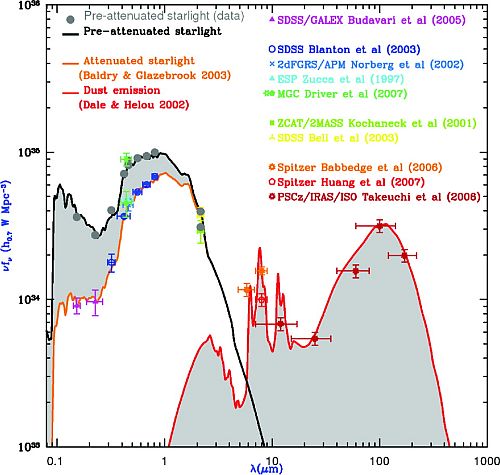 | |||
|
| Home > Public Information > Scientific Highlights > 2008 > The Universe Shines Twice as Bright |
The Universe Shines Twice as BrightINT+WFC
The cosmic spectral energy distribution (CSED) provides a description of the current total electromagnetic energy output of the universe over all wavelengths. In the ultraviolet, optical, and near-infrared wavebands it is dominated by starlight, and its measurement can be used to constrain the current stellar mass density and cosmic star formation rate as well as models of galaxy formation.
However, galaxies contain interstellar dust grains, which, while negligible in terms of mass, attenuates some unknown fraction of the starlight before it exits a galaxy into the intergalactic medium. The severity of this effect has proved difficult to quantify, leading to large uncertainties in individual galaxy flux measurements and consequently a systematic underestimation of individual CSED measurements. The degree to which the CSED is underestimated depends on wavelength, the amount and distribution of the dust within the host galaxy, and galaxy's orientation to our line of sight. A team of astronomers combined an innovative new model of the dust distribution in galaxies with data from the Millennium Galaxy Catalogue, a high resolution catalogue of 10,000 galaxies compiled with data obtained using the Wide Field Camera on the Isaac Newton Telescope. The dust absorbs starlight and re-emits it, making it glow. They knew that existing models were flawed, because the energy output from glowing dust appeared to be greater than the total energy produced by the stars. Using the new model, the astronomers could calculate precisely the fraction of starlight blocked by the dust. The key test that the new model passed was whether the energy of the absorbed starlight equated to that detected from the glowing dust, and the equation balanced perfectly. They find that only 11% of the ultraviolet photons escape their host galaxies; this value rises linearly with log λ to 87% at infrared. They deduce that the energy output from stars that escapes directly into the intergalactic medium is approximately 50% in the nearby universe, so the Universe is actually twice as bright as previously thought because dust is obscuring approximately half of the light that the Universe is currently generating. This study has provided for the first time ever a global understanding of the energy output of the Universe over a monumental wavelength range.
More information:
|
| Top | Back |
|


